A “smart” Barbie doll that can have “conversations” with children should not go on sale, privacy advocates have said.
Billed as the world’s first “interactive doll”, the toy uses voice recognition technology similar to that employed by Apple’s Siri and Google’s Now digital assistants to understand what a child is saying to Barbie and respond.
However, privacy advocates are worried about the use of voice recognition technology that sends recordings of children to third-party companies for processing, potentially revealing his or her intimate thoughts and details.
“If I had a young child, I would be very concerned that my child’s intimate conversations with her doll were being recorded and analysed,” said Professor Angela Campbell of Georgetown University law school.
“In Mattel’s demo, Barbie asks many questions that would elicit a great deal of information about a child, her interests, and her family. This information could be of great value to advertisers and be used to market unfairly to children.”
The conversation capabilities of the Hello Barbie toy from Mattel are powered by a venture capital-backed San Francisco startup called ToyTalk, which receives and interprets speech recorded by a microphone in the doll before initiating a pre-programmed vocal response. Crucially, the data is stored by ToyTalk for use beyond the immediate response.
“ToyTalk and Mattel will only use the conversations recorded through Hello Barbie to operate and improve our products, to develop better speech recognition for children, and to improve the natural language processing of children’s speech,” a ToyTalk spokesperson said.
The toy connects to the internet via Wi-Fi and is capable of understanding and responding to complex natural language patterns. The doll can answer questions built on data gleaned from previous conversations with the child, such as “what should I be when I grow up?”.
In one demonstration it suggested being a dancer or a politician, or a “dancing politician” after learning that the child likes to be on-stage.
“Kids using ‘Hello Barbie’ aren’t only talking to a doll, they are talking directly to a toy conglomerate whose only interest in them is financial,” said Susan Linn, executive director of the Campaign for a Commercial-Free Childhood. The group is attempting to stop the sale of the toy, which is scheduled for the Christmas rush this year. “It’s creepy – and creates a host of dangers for children and families.”
Before the toy can be used, parents must set up an account and agree to various privacy policies. The toy only listens to the child after a button on its buckle is pressed prompting it to ask a question. The audio recorded is encrypted before being sent over the internet.
According to ToyTalk’s privacy policy, the company shares audio recordings with third parties that “assist us with speech recognition” and that those third parties can keep any data derived from those audio files.
The voice recognition technology used by Mattel and ToyTalk operates in a similar manner to almost any other, including commonly used voice search functions. But a lack of user understanding, and the involvement of children, who are potentially incapable of understanding that their actions are being monitored, has raised concerns.

Comments (…)
Sign in or create your Guardian account to join the discussion